When we mention “fish collecting”, it will surely raise a few eyebrows. Some will look in awe; imagining the long drive, walking through jungles and bushes, battling biting insect and blood-sucking leeches. Others will probably give you the disgust look, knowing the fact it is dirty, wet and soggy in the field. A few will disapprove the practice. They will say, it will decimate the fish population. It maybe true in some aspect but not in all parts. Rampant and uncontrolled collection for commercial purpose will definitely cause some problem. But a properly conducted collection by well informed and responsible hobbyist will not make a dent in the wild population; especially if some good practices (or rules) are followed. One of it is the rule of “2 for 1”; i.e. 2 pairs for each person.
In fact, a lot can be gained by doing so. Being able to see the biotopes will give us the opportunity to learn the exact requirements of the target species. We can know the suitable temperature, pH, water hardness and sort and will give us the chance to replicate those in our aquaria. Nothing beats the original but the best we can do is to get as close as possible. Beside, seeing the healthy fishes in our tanks knowing the fact you have shed sweat and tears to catch them is one heck of a feeling. In other aspect you might be helping the wild population by distributing the subsequent spawns to other hobbyists. This will ease the demand in the trade and reduce commercial collecting from the wild habitats. When the buying stop, the "killing" stop (from Animal Planet).
Regards,
Zahar AZ
Malaysia
For those who do not have the privilege to visit the biotopes, here are some photos to share....
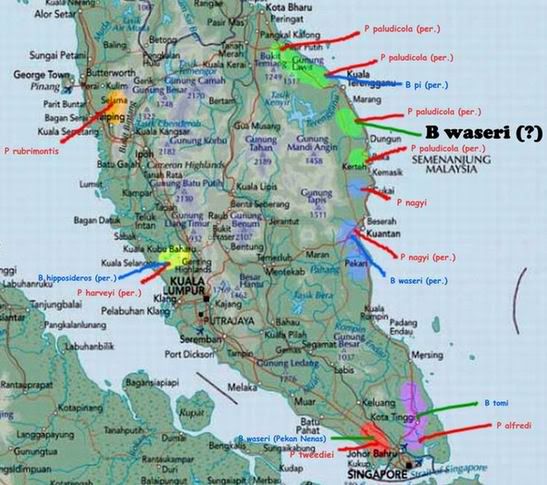
The map was originally made to discuss the true identity of the B waseri “Rantau Abang”, which if it follows the pattern (my theory) of one paros – one waseri group (as depicted), it will be some other species. Probably a Betta pi.Ignore the betta (markings) as the discussion is beyond the scope of this thread.
Regards,
Zahar AZ
Malaysia
This is the infamous Tg Malim, or correctly known as North Selangor Peat Swamp Forest, home of B livida.
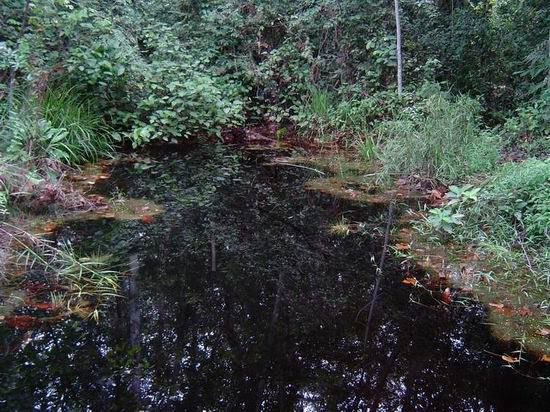
Some of the catches:
Rasbora kalochroma

Helostoma temminckii; wild form of the kissing gouramy
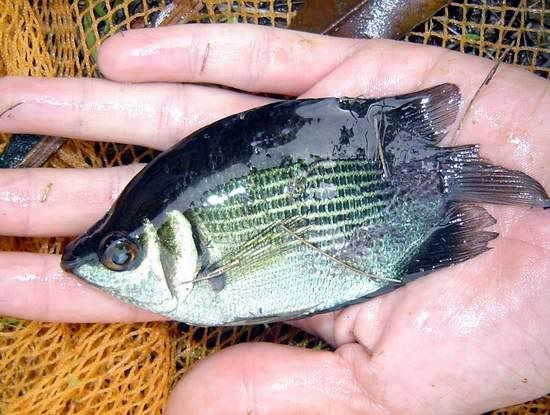
Puntius pentazona
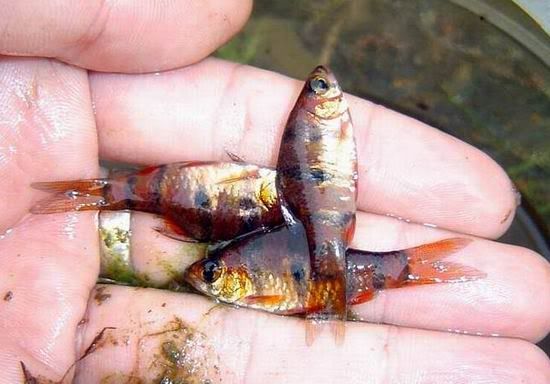
Regards,
Zahar AZ
Malaysia
Adult B hipposideros

L pulcher
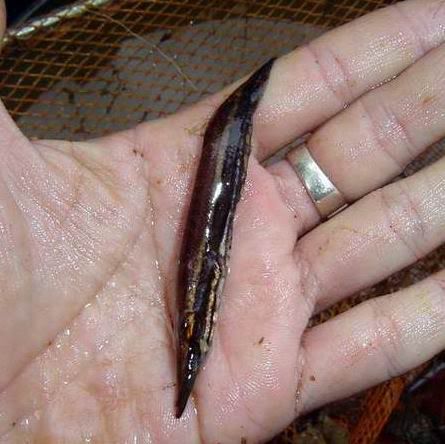
Along the banks with overgrown grass like this, we caught P harveyi. Its laterally compressed body fits nicely between the vertical growth of the grass and other plants.
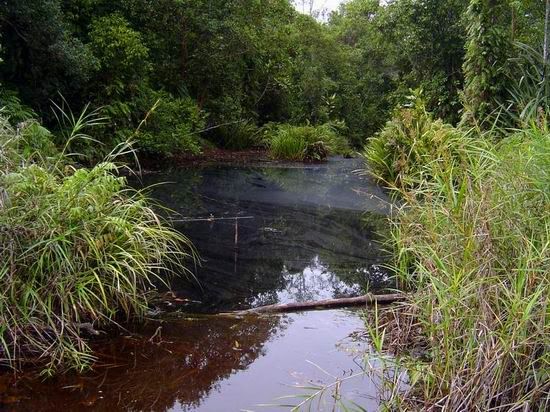
A beautiful male P harveyi
Regards,
Zahar AZ
Malaysia
In Pasir Puteh, Kelantan a small (3 metres in average) stream flows out of a tropical fruit plantation. The flow is of moderate strength, and the water is clear with white sandy bottom. Under the tree shades, healthy carpets of C cordata cover the banks and the shallow areas. pH recorded as 5.8 – 6.0 (February 2006).
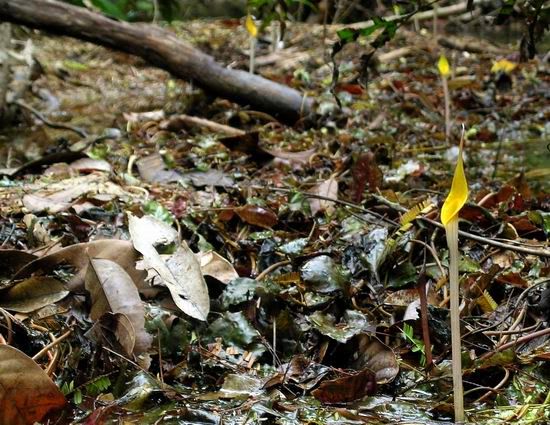
Close up of the flower

Healthy growth of crypt indicates healthy stream, and this is seen in the number of fishes in it.
Regards,
Zahar AZ
Malaysia
A large R sumatrana - one of the most common species, together with Puntius binotatus
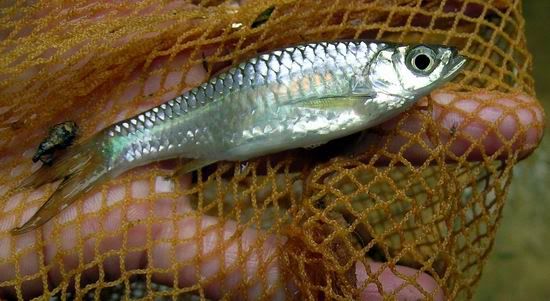
T heteromorpha

A halfbeak (species?)
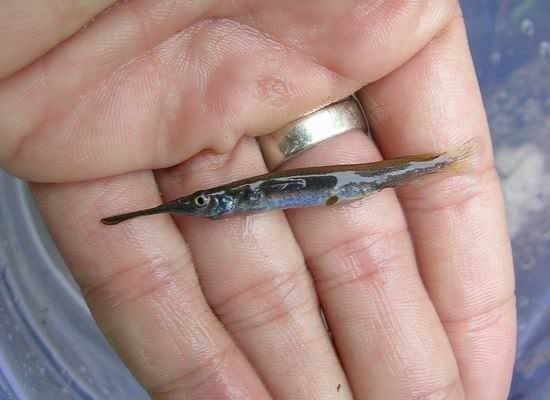
A shrimp

Regards,
Zahar AZ
Malaysia

.. and from under the leaves of the crypt, our subject of interest : P paludicola
A female
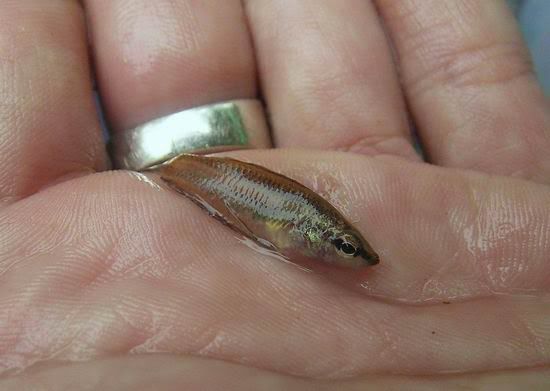
A nice, well fed male
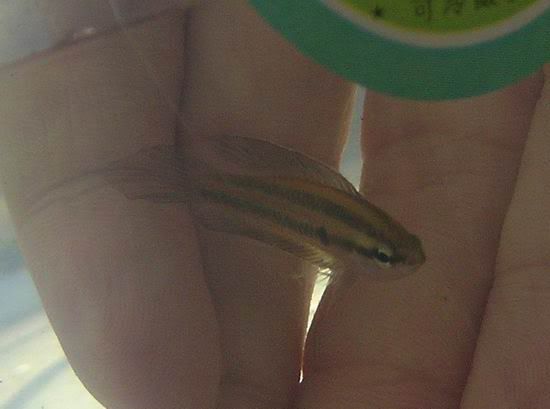
Regards,
Zahar AZ
Malaysia
Hi zahar,
this very interessting pictures and information about the biotopes are amazing!
I like to see selfmade pics of the biotops and fish by active people like you. It's so amazing to see it.
Your map is full of good information about the areas we can find the Paros and Bettas. Hopefully i will go to those places in the future!
Didn't you find Bette persephone & coccina in the Selangor Peat Swamp Forest? I thought this area is home of this bettas.
Thanks for this thread.
chris
IGL 115
Zahar, thank you very much! I am happy that you have become a member of this Forum!
Zahar, danke! Ich bin sehr froh darüber, dass Du ein Mitglied dieses Forums geworden bist!
Wonderful pictures, a lot of information in the map!
Peter Finke, Bielefeld
Hi zahar,
this very interessting pictures and information about the biotopes are amazing!
I like to see selfmade pics of the biotops and fish by active people like you. It's so amazing to see it.
Your map is full of good information about the areas we can find the Paros and Bettas. Hopefully i will go to those places in the future!Didn't you find Bette persephone & coccina in the Selangor Peat Swamp Forest? I thought this area is home of this bettas.
Thanks for this thread.
chris
Thanks. It's a pleasure to share. But I don't know how long will all these places last. Some of the biotopes are already gone (swallowed by human greed and lust - development).
Coccina and persephone are from Ayer Itam (Johor) - further south. In Tg Malim, it all about livida, hippo, bellica and P harveyi.
Regards,
Zahar AZ
Malaysia
Zahar: The beautiful male P. harveyi in the photograph above seems to have some brownish-reddish colour in the caudal fin, or am I mistaken? The harveyi we saw until today had no brown-red colours at all.
Could you kindly explain to us whether this is true to your experience, or not?
Peter Finke, Bielefeld
Zahar: The beautiful male P. harveyi in the photograph above seems to have some brownish-reddish colour in the caudal fin, or am I mistaken? The harveyi we saw until today had no brown-red colours at all.
Could you kindly explain to us whether this is true to your experience, or not?
Yes, that's my hand. Those photos were taken in August 2004.
I was myself a bit suprise to see the fishes (with a red band in the caudal fin as opposite to the other photos and the papers; see ) but took the pattern as a natural variant. But since you raise the issue, here's an old photo:
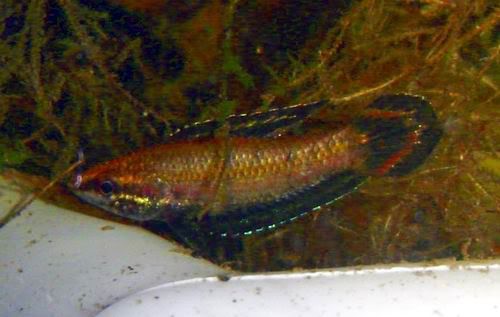
A sleeping male
In fact, a friend recently asked about this sort of colouration in one of his fish.
BTW, thanks for pointing this up.
Regards,
Zahar AZ
Malaysia
I am entirely puzzled, Zahar, by that last photograph: that should be a P. harveyi? Not only the red colour in the caudal puzzles me, but also the structure of the red bands (as compared with the structure of the blue markings in the harveyi we know); compare our new gallery: go to "Artenliste" in the Parosphromenus-Forum and then click P. harveyi), and the (nearly) stripeless colour of the whole body of the fish!
Question to all: Hat irgendeiner von uns diesen Fisch schon einmal gesehen? Has anybody seen this fish before??
Peter Finke, Bielefeld
Ja, dass Bild ist überraschend, interessant wäre zu erfahren, wie die anderen Fische aus diesem Biotop aussahen. Zahar, I think you caught more Parospromenus at Tanjung Malim, how do they look like. The same red pattern in caudal, ore like we know P. harveyi (see gallery)? Did you breed them, how is the colour of the young paros (red father)?
Die bintan Gruppe wird uns noch viel Freude in der Systematik machen. Ich habe schon häufig hierzu meine Meinung kundgetan. Es scheint aber auch offensichtlich mehrere Farbtypen (manche würden Arten dazu sagen) parallel im Verbreitungsgebiet zu geben. Man kann das durch eine Mutation oder durch Farbvarianz erklären. Oder man kann eine weitere Art beschreiben. (Das werden in der Konsequenz aber viele).
Tatsächlich sind uns Übergangsformen bekannt, es kamen in Vergangenheit immer wieder Formen zu uns, die bei genauer Betrachtung, äußerlich zwischen zwei anderen "Arten" vermittelten.
Man nehme P. tweediei I ("Pontian"): Hier ist man geneigt, die Artbeschreibung zu akzeptieren, da sie sozusagen den rein roten Typ beschreibt.
Dann, als anderes Extrem P. harveyi, dem die Rottöne fehlen und der rein türkise Bänderungen zeigt.
Dazwischen bewegt sich als eindeutige Übergangsform P. tweediei II (Ayer Hitam), das waren die Fische, die Schaller mitbrachte und Foersch und Richter dokumentierten und die Kottelat zu P. tweediei zählt. Das, obgleich sie parallel zu der (zugegebenermaßen) dominanten roten Bänderung, türkise Bänder in den unpaaren Flosssen zeigen.
Wie weit liegen P. rubrimontis und alfredi denn davon weg?
Um die Verwirrung zu erhöhen. Ich habe parallel (aus einem Import) ein extrem rotlastiges Männchen P. opallios ohne türkise Bänderung und eines mit deutlicher türkiser Bänderung (besser gesagt: Peter hats jetzt). D. h. es gibt definitiv eine gewisse Varianz in den Typen. Ich werde in Belzig Bilder zeigen.
Wenn wir noch ein bischen machen und Übergangsformen suchen (vielleicht sucht mal einer, wie ich es versuchte, neue Biotope und fischt nicht nur die altbekannten ab!), "verschwimmt" die Definition unserer sechs "Arten" der bintan-Gruppe. Was definitiv bleibt, ist der verschiedene Fundort und ein Standard, den man pro Art festlegen könnte. Diese Aussehensstandard besteht in der Feststellund ausschließlich der FARBLICHEN Verteilung von Farben bzw. Zeichnungen der Männchen in Prachtfärbung. Rein Türkis über Türkis/Rot zu rein Rot. Auch im Verhalten sind die bintan-Typen extrem homogen.
Ich will keinesfalls bestreiten, dass man nicht alle 6 Arten der bintan-Gruppe deutlich gegeneinander unterscheiden könnte. Hat man sie in Prachtfärbung nebeneinander, sind die Standardtypen gut zu unterscheiden. Wenn es da die Übergangsformen und die offensichtliche Varianz in der Population nicht gäbe, wäre alles in systematischer Ordnung. Wir müssen ja heute davon ausgehen, dass unser Wissen sich aus punktuellen Fängen (von Wissenschaftlern und Hobbyisten) rekrutiert. Eine systematische Erhebung durch Abfischen ganzer Regionen gibt es nicht. Und sofern es sowas mal partiell gab, war das Ergebnis in diesem Verbreitungsgebiet immer gleich: Ein -4cm langer Fisch mit runder Caudale und Längsstreifung gab`s da, genannt P. deissneri (Schnell weg damit, gilt nicht mehr!) Bis Kottelat kam und sich die Zeit nahm, die Fische im auch im Aquarium oder auf Fotos in Prachtfärbung zu betrachten (bzw. das verwertete, was Aquarianer (überwiegend) aus der IGL (Linke, Neugebauer, Frank, Kopic...) an Dokumentationsarbeit geleistet hatten). Vorher fanden die, kurz nach dem beim Fang nicht mehr objektiv feststellbaren, Farbunterschiede keine Beachtung.
Als letztes führe ich P. nagyi "Cherating" auf. Wir fischten 2000 in der Nähe von Cherating in zwei (einige 100m voneinander erntfernten) Bächen. Die dort gefangenen Paros (diese waren untereinander pro Biotop homogen) unterschieden sich schon innerhalb dieser beiden Bäche. Ich hielt die aus dem einen Bach, zunächst für sowas wie P. sp. aff. harveyi. Heute glaube ich an eine andere Ernährungslage, andere chemische (Wasserzusammensetzung) oder physikalische (Strömung, Biotop....) Rahmenbedingungen oder etwas in diesem Sinne.
Wenn man nun P. nagyi "Cherating" mit P. nagyi "Kuantan" vergleicht, so stellt man doch auch Unterschiede fest. So sind alle Bänderungen und Säume bei "Cherating" türkis, bei "Kuantan" ist die Bänderung der Caudale weiß. Und P. n. "Kuantan" zeigen einen markanten schwarzen Fleck (auch als Jungtiere) in der hinteren Basis der Dorsale. Wollen wir daraus zwei Arten machen. Nein, eindeutig nicht! Wir stellen nur fest, dass zwei, voneinander 70km entfernte Fundorte, unterscheidbare Typen hervorbringen können. Das bedeutet für mich, dass eine Art mit einem hierzu vergleichsweise riesigen Verbreitungsgebiet (Sumatra, Malayische Halbinsel, Banka, Bintan, Westborneo), wie die bintan Formen, selbstverständlich Lokalformen und Farbrassen entwickeln. Wäre verwunderlich, wenn nicht. Es geht mir hierbei ausdrücklich nicht um Kritik an den Beschreibern bzw. um die Definition vom Artbegriff, sondern um an diesem Beispielen die Komplexität biologischer Zusammenhänge zu zeigen. Natürlich hat unsere spezielle Aquaristik etwas mit "Verstehen-wollen" und trotzdem "Erklären-können" zu tun.
Übrigens ist die helle, streifenlose Färbung ist kein Indiz für eine andere Art, sondern zeigt die typische Agressionsfärbung der bintan-Typen. Vielleicht hatte der Paro einen schlechten Traum.
Übrigens gehört P. nagyi nicht zu der bintan-Gruppe und ich wage die Aussage, dass es sich um eine eigene Art handelt und bete, dass keiner eine Übergangsform findet.
Martin Hallmann
First of all I don't have any explanation about the fish colouration. How nor why.But one thing for sure, it came from Tg Malim. In fact, I just spoke with a colleague who is now keeping 5 fishes (all males) and interestingly one has similar red band on the caudal fin. Could it be a mutation or a normal variant? Or could it be distint species (from P harveyi that we all know ie no red) as suggested by a friend here? I don't have the answer.
To make thing worse, the fish (and a female) was the only male specimen that I brought back. The rest were distributed to other hobbyists. Unfortunately they didn't spawn till their untimely demise (blame it on my inexperience at that time) and I can't remember how the rest of the fishes from that trip looked like.
The only thing that I'm sure is, to get my hands on some new samples and photos. As for now that's about all from me.
Regards,
Zahar AZ
Malaysia

